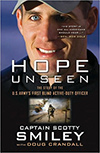NEWS Center
Stevens Institute of Technology Master’s Students learn leadership lessons at TLDGThursday, January 08, 2015
Steven's Institute of Technology master's students head to TLDG at West Point to put ethics of leadership, communication, and teamwork to the test!

If you were navigating an enemy minefield and tasked with laying a bridge for your teammates to cross safely, you’d probably be more worried about safety and survival than following the rules.
Not so for Peter Flynt.
Flynt, a student in the Howe School of Technology Management’s weekend executive master’s program, had just scaled a wall and was setting a board for his teammates to use as a bridge when the board touched an out-of-bounds area.
No mines exploded — the “minefield” was actually just section of off-limits ground on an obstacle course — but rather than cheat, Flynt immediately looked for his group’s observer/controller to determine what the penalty would be.

That idea — that ethics should be a central point of leadership — is part of why Flynt and 20 of his classmates were completing the leadership reaction course at the Thayer Leader Development Group at West Point, NY, at the Historic Thayer Hotel on the famed U.S. Military Academy.
It’s a value firmly ingrained in Flynt, but it’s one he sees emphasized in his Stevens training.
“Ethical leadership can be learned, it can be taught, but ultimately, it has to be practiced,” said Flynt, an assistant vice president at New York City’s Economic Development Corp. “This leadership course is a great chance to show you really need to think of these things, because they do impact you in the long run.”
Learning by doing — and doing it right
That sort of attitude is exactly what Howe School Professor Gary Lynn had in mind when he worked with TLDG to offer the outdoor leadership seminar for Stevens graduate students.
“It’s not just about teamwork and leadership training,” Lynn said. “West Point emphasizes ethical leadership and teamwork, like Stevens with its own honor code. Everybody wants an ethical leader. In today’s age, it’s easy to take the shortcut for the quick buck. And we’re trying to train leaders that will take the longer way, but the surer way, from point A to point B.”
It’s how Stevens emphasizes not just learning by doing, but doing it the right way.
“It’s one thing to teach leadership skills in the classroom,” Lynn said. “It’s another to be out in the field leading your team over questionably dangerous obstacles, and our students rise to the challenge.”
The ethical tradition at West Point is one the Thayer Leader Development Group is eager to emphasize, said Todd Gile, its director of business development and a retired Lieutenant Colonel in the Army. The training emphasized in the leadership reaction course is much like cadet training, he said.
“The idea is to give people as many opportunities to experience potential ethical situations, then have them discuss, review and think about it, so the first time they see it is not when they’re in an actual ethical situation,” Gile said.

Putting skills to the test
The weekend executive master’s program at Stevens is designed for experienced professionals who have been in the workforce for at least five years. Classes, which meet every other Saturday, emphasize training in management of people and technology, to produce well-rounded leaders who understand how to leverage technology to improve processes and decision making, and maximize value, for their organizations.
Students in the program can pursue either a 48-credit executive MBA or the 36-credit M.S. in Technology Management. In addition to a rigorous curriculum that’s developed with insight from industry partners, the program emphasizes leadership and teamwork skills, through events like the weekend at West Point, and exposure to international culture, through a study abroad trip to China.
The purpose of the West Point weekend, Lynn said, is to give students a chance to develop the camaraderie that’s a hallmark of Stevens’ executive master’s programs while also getting them to put their leadership skills to test. It certainly rings true when you watch students hoisting one another over walls or through tunnels as they complete mock scenarios where they must transport live ammunition to stranded combat units or organize an escape from a POW compound without talking.
“It’s an experience that transcends the classroom,” Lynn said. “We like to think they listen to us in class, but out here, whether they succeed or fail, it’s based on the support of their team and how well they lead, communicate and trust each other.”
And there’s an immediate practical component, said student Liza Banhalmi, who works in control systems at a power utility.
“If something breaks in the plant, if I’m busy, I have to send my technicians out there to check it out, and I have to trust in what they do,” Banhalmi said. “Same thing with the obstacles. There were points where there were blind spots, and I had to trust my teammates on what was on the other side. At my job, I have to trust the people that I work with who have more experience, and I have to be able to trust the knowledge they gather when they get to a problem first.”
Trust is a hugely important component, and while teams often start slowly, by the time they’ve completed their fourth or fifth task together, they’re comfortable working together and have a good sense of each others’ strengths and weaknesses.
“It’s a tremendous team-building event, to do something together — particularly when it’s physical, when they have to touch each other, pull each other up, push on each others’ rear ends — it’s obviously an opportunity to get to know each other a lot better than they would just being in a classroom,” Gile said. “To think through these hard things, to expose themselves, to make mistakes — it’s part of that safe environment that they get to allow their classmates to see what they’re really about.”

A big part of the obstacle course is the five minutes for reflection built into each component. Each time, teammates discussed what worked, what didn’t work and how to use that information to go forward, along with assessing the leader’s performance. Those discussions were facilitated by the observer/controllers, or OCs, who pointed out some things teams may have missed in the heat of the moment.
Flynt’s infraction with the board occurred in his team’s second obstacle of the day. The group’s OC, Fran Wolf, noted a real improvement in the dynamics of the team as they approached the second task.
“On the first task, we were confused,” said student Ray Baig. “We were looking at each other, wondering what should we do. This time, we knew there were roles and responsibilities.”
Student Martin Dziasek, who came up with a number of strategies for the team during the day, said he liked how “when people noticed an idea wasn’t going to work, they just said it, and we moved forward.”
“And we’re starting to see each other’s strengths,” he said. “Early on, we knew Peter was the most fit here, so most of the things that needed more dexterity, Peter was doing — and I think that helped too, all of us had confidence in him to do those things.”
Flynt said his acrobatics were made simpler because “there were definitely more hands going out to help as our comfort level with each other grew, compared to earlier tasks.”
Steering it back to business
For Professor Pete Dominick, the chance to watch the teams reflect on their performance brings to life the learning by doing approach that’s pivotal to the Howe School.
“We always think about leadership as being about doing and action,” Dominick said. “But what you see here is the listening, the learning part of leading.”
Dominick, who also teaches leadership development for technical professionals and organizations, also brought up Flynt’s infraction with the board, and how “you guys didn’t cheat yourselves on it,” even though the OC, Wolf, didn’t penalize the group, since he “didn’t want to wreck the flow” of what was a good learning experience in action.
“In life, we’re going to come up against obstacles, were gong to come up against regulations, boundaries, and you go past a boundary, and there are penalties involved with that,” Wolf said.
Wolf wasn’t the only OC to steer the conversation toward practical application of what the teams learned. After watching three people in his group attempt to scale a wall the same way, only to each wind up out of bounds and penalized, Gile pointed out that “it’s funny how we get caught doing something a certain way, and can’t think of doing it a different way. But doing things differently is how we make great strides in business.”
And Kate Wender, after watching student Lou Zimick lead his team through the POW compound, pointed out that knowing how to best deploy assets is just as valuable in an office as it is on the obstacle course.
“You’re understanding the strengths and weaknesses of your team and how to utilize them, and you’re realizing that a weakness you may have, a teammate may be able to help you with,” Wender said.

In that case, Zimick succeeded by limiting the information he provided to his team. After scaling the wall of the compound and noting the 15-foot-drop that would have to be made with ropes, he shared only a few details to keep his teammates at ease.
“I wanted to give them enough information where they weren’t scared about what they had to do, because I knew heights was a fear for them,” Zimick said. “I really had confidence that we were going to get over it.”
Practical emphasis
That emphasis on practical leadership, driven from trust and understanding, was especially notable by the time the day concluded. Flynt and his teammates needed only a couple of minutes to hatch a plan to complete a tricky course — involving careful suspension of long boards to cross aerial gaps — and finished with several minutes to spare.
“We just started trusting each other,” Baig said. “If Martin is coming up with something out of the box, we weren’t debating that, we were just trusting him and going with that kind of solution.”
By the last course, Dziasek said, “everyone realizes where the team’s strengths are, and everyone as a group is saying, ‘Hey, you go there; you do that; you there,’ so we deploy assets in the best way.”
For Wolf, their OC, it was a good message to end the group’s discussion with.
“Be vocal, as you get back to your teams at school and work, about trying to bring in, trying to figure out what those skills are,” he said. “As a leader, you’ve got to bring those out of your teammates. If you fail to leverage those strengths your team will fail to perform as well as it could.”
To learn more about leadership development at TLDG, contact Todd Gile, director of business development, at (906) 360-3335 or tgile@thayerleaderdevelopment.com.
- See more at: http://www.stevens.edu/news/west-point-ethics-leadership

"Most people spend 90% of their time on tasks and 10% on leadership. Start spending 50% of your time on leadership and you will notice that others will pick up the slack on the tasks."
Colonel Sean Hannah, Ph.D.,(USA, Retired, University of Nebraska)
More +
More +





